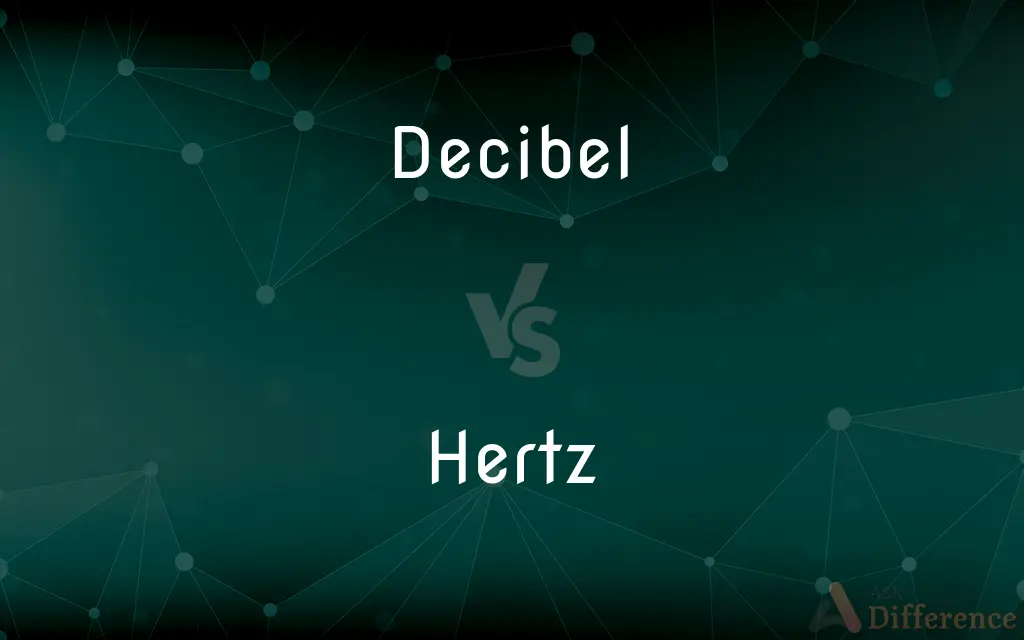Decibel vs. Hertz — What's the Difference?
Edited by Tayyaba Rehman — By Fiza Rafique — Updated on September 22, 2023
Decibel measures the intensity or power level of a sound or signal, often in a logarithmic scale. Hertz measures the frequency of oscillation or vibration in cycles per second.

Difference Between Decibel and Hertz
Table of Contents
ADVERTISEMENT
Key Differences
Decibel and hertz are units of measurement used primarily in the fields of acoustics, electronics, and telecommunications, but they measure different aspects. A decibel (dB) is used to quantify the intensity, power, or level of sound or other signals. Hertz (Hz), on the other hand, is the unit that measures the frequency of a wave, often referring to sound, electromagnetic waves, or other periodic phenomena.
In audio engineering and acoustics, the term "decibel" is frequently used to express the loudness or amplitude of a sound. For example, a whisper might be around 30 dB, while a jet engine could be over 120 dB. In these same fields, "hertz" is used to describe the pitch of the sound. A low-frequency sound like a bass drum may oscillate at 100 Hz, while a high-frequency sound like a piccolo could be at 4000 Hz.
In telecommunications and signal processing, the word "decibel" is often used to express signal-to-noise ratios or gains and losses in a system. "Hertz," in contrast, is commonly utilized to indicate the frequency bands over which systems operate. For instance, FM radio operates in the range of megahertz, while Wi-Fi signals are in the gigahertz range.
Decibel measurements often use a logarithmic scale to deal with the vast range of human hearing and signal power. This makes it easier to compare values that might differ hugely in magnitude. Hertz, however, uses a linear scale, counting the number of cycles completed per second. Both units serve essential but different roles in describing waves and signals.
Comparison Chart
Measures
Intensity, power, or level
Frequency
ADVERTISEMENT
Used in Fields
Acoustics, telecommunications, signal processing
Acoustics, telecommunications, signal processing
Scale
Logarithmic
Linear
Units
DB
Hz
Associated Characteristics
Loudness, signal strength, signal-to-noise ratio
Pitch, oscillation rate, frequency band
Compare with Definitions
Decibel
Decibel can also quantify other types of signals beyond sound.
The decibel gain of the amplifier was significant.
Hertz
Hertz measures the frequency of oscillation in cycles per second.
The tuning fork vibrates at 440 hertz.
Decibel
Decibel values often use a logarithmic scale.
Decibels make it easier to compare vastly different sound levels.
Hertz
Hertz can also refer to electromagnetic wave frequencies.
FM radio operates in the range of megahertz.
Decibel
Decibel is used to express signal-to-noise ratios in telecommunications.
A higher decibel value indicates a cleaner signal.
Hertz
Hertz uses a linear scale for measurement.
The frequency doubled from 50 hertz to 100 hertz.
Decibel
Decibel measures the intensity or power level of a sound.
The decibel level at the concert reached 110 dB.
Hertz
Hertz is abbreviated as Hz.
The processor speed is clocked at 3.5 GHz (gigahertz).
Decibel
Decibel is abbreviated as dB.
The noise level was measured at 45 dB.
Hertz
Hertz is commonly used to describe sound frequency.
The pitch of middle C is approximately 261.63 Hz.
Decibel
The decibel (symbol: dB) is a relative unit of measurement equal to one tenth of a bel (B). It expresses the ratio of two values of a power or root-power quantity on a logarithmic scale.
Hertz
The hertz (symbol: Hz) is the derived unit of frequency in the International System of Units (SI) and is defined as one cycle per second. It is named after Heinrich Rudolf Hertz (1857-1894), the first person to provide conclusive proof of the existence of electromagnetic waves.
Decibel
A unit used to express relative difference in power or intensity, usually between two acoustic or electric signals, equal to ten times the common logarithm of the ratio of the two levels.
Hertz
The SI unit of frequency, equal to one cycle per second.
Decibel
A common measure of sound intensity ratio that is one tenth of a bel on the logarithmic intensity scale. It is defined as dB = 10 log10(P1 / P2), where P1 and P2 are the relative powers of the sound.
Hertz
A unit of frequency equal to one cycle per second. See Table at measurement.
Decibel
A logarithmic unit of sound intensity; 10 times the logarithm of the ratio of the sound intensity to some reference intensity
Hertz
In the International System of Units, the derived unit of frequency; one (period or cycle of any periodic event) per second. Symbol: Hz
Hertz
A unit of frequency equal to one cycle per second; it is abbreviated Hz. It is commonly used to specify the frequency of radio waves, and also the clock frequencies in digital computers. For these applications, kilohertz and megahertz are the most commonly used units, derived from hertz.
Hertz
The unit of frequency; one Hertz has a periodic interval of one second
Hertz
German physicist who was the first to produce electromagnetic waves artificially (1857-1894)
Hertz
German physicist who with James Franck proved the existence of the stationary energy states postulated by Bohr (1887-1975)
Common Curiosities
Is the decibel scale linear or logarithmic?
The decibel scale is logarithmic.
Is the hertz scale linear or logarithmic?
The hertz scale is linear.
What does hertz measure?
Hertz measures the frequency of oscillation or vibration in cycles per second.
Is hertz only used for sound?
No, hertz is used for any periodic oscillation, including electromagnetic waves like radio frequencies.
What is the abbreviation for hertz?
The abbreviation for hertz is Hz.
How does decibel relate to human hearing?
Decibel levels help quantify the loudness of sounds as perceived by human ears.
What does decibel measure?
Decibel measures the intensity, power, or level of a sound or signal.
How does hertz relate to pitch in music?
In music, the frequency of a note in hertz correlates with its pitch.
Can decibels be negative?
Yes, decibels can be negative, often indicating a loss or attenuation of power.
Can decibel be used for things other than sound?
Yes, decibels can be used to measure the strength of various types of signals, not just sound.
What is the abbreviation for decibel?
The abbreviation for decibel is dB.
What’s a common use of decibel in telecommunications?
In telecommunications, decibels are used to express signal-to-noise ratios.
Can both decibel and hertz be used to describe a single sound?
Yes, a single sound can be described using both its decibel level to indicate loudness and its frequency in hertz to indicate pitch.
Are lower hertz values associated with lower pitch?
Yes, lower hertz values generally correspond to sounds with lower pitch.
What's the significance of gigahertz in computing?
In computing, gigahertz (GHz) often describes processor clock speeds.
Share Your Discovery

Previous Comparison
Correct vs. Yes
Next Comparison
Broadcasting vs. TelecastAuthor Spotlight
Written by
Fiza RafiqueFiza Rafique is a skilled content writer at AskDifference.com, where she meticulously refines and enhances written pieces. Drawing from her vast editorial expertise, Fiza ensures clarity, accuracy, and precision in every article. Passionate about language, she continually seeks to elevate the quality of content for readers worldwide.
Edited by
Tayyaba RehmanTayyaba Rehman is a distinguished writer, currently serving as a primary contributor to askdifference.com. As a researcher in semantics and etymology, Tayyaba's passion for the complexity of languages and their distinctions has found a perfect home on the platform. Tayyaba delves into the intricacies of language, distinguishing between commonly confused words and phrases, thereby providing clarity for readers worldwide.
















































